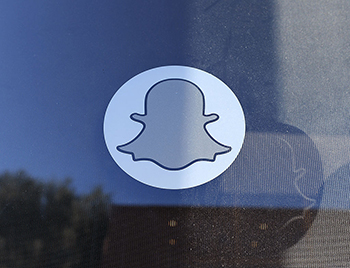(单词翻译:单击)

The company behind Snapchat, the disappearing message service headquartered a stone’s thrown from Los Angeles’ tawdry Venice Beach, has long revelled in its non-Silicon Valley vibe: more streetwise, less overtly techie, and out to spawn fun rather than change the world.
提供阅后即焚消息服务的Snapchat,总部所在地距离俗丽的洛杉矶威尼斯海滩(Venice Beach)仅一箭之遥。该公司长期以来一直陶醉于自己不同于硅谷的氛围:更潮,技术公司属性不那么明显,以创造乐趣而不是改变世界为使命。
And how better these days to set yourself apart from the Valley tech establishment than race to an initial public offering? Staying private for as long as possible has been the norm for the tech companies based closer to the traditional California tech heartland.
而如今,还有什么比火速首次公开发行(IPO)更能让你区别于硅谷成熟科技企业的方式?尽可能久地保持公司的私人性质,一直是位置更靠近传统加州科技中心地带的技术公司的惯常做法。
By appointing bankers this week and with an eye to selling its shares on Wall Street as early as March, five-year-old Snap (as it was recently renamed) is leaping ahead of companies as long in the tooth as Uber(set up seven years ago), Airbnb(eight), Dropbox(10) and Palantir(13).
上周,成立5年的Snap(不久前Snapchat已改为这个名字)已指定银行家,打算最早于明年3月在华尔街销售其股票,步伐超过了优步(Uber,成立于7年前)、Airbnb(成立于8年前)、Dropbox(成立于10年前)和Palantir(成立于13年前)等一批较老的公司。
The news of Snap’s stock market intentions comes as shares in Twitter— the Valley’s last blockbuster IPO, three years ago — have been bounced around by talk of on-again, off-again takeover discussions.
Snap打算登陆股票市场的消息传出之际,三年前上市的Twitter——硅谷的上一笔引发轰动的IPO——的股价,正受时断时续的收购谈判的影响而上下波动。
This coincidence feeds an obvious narrative: as one experiment in mobile messaging loses momentum, another is on the rise.
这恰好支持了一种显而易见的论调:当移动消息传送领域的一种尝试势头下降时,另一种尝试风头正劲。
Given the vagaries of social media taste and the speed with which new fads take hold, can Snap’s moment in the sun be any more lasting? The comparison is superficially appealing but misleading, although there are certainly some striking similarities between Snap now and Twitter back in 2013.
鉴于社交媒体口味的变化莫测以及新潮流的确立速度,Snap的风光时刻可能会更持久吗?这种对比在表面上看很吸引人,但具有误导性——尽管如今的Snap跟2013年的Twitter当然存在着一些明显的相似之处。
The tweet machine was riding a strong growth curve when it went public.
Twitter当年上市时,其增长趋势正强劲。
More than 100m of Twitter’s users were visiting daily, and its audience had doubled from a year before.
当时Twitter的每日用户访问量超过1亿,并且这个数字一年增加了一倍。
Snap’s disappearing messages have put it on a similar trajectory.
Snap的阅后即焚消息也划出了类似的轨迹。
It passed 150m daily active users four months ago, up 70 per cent from the year before.
4个月前,其每日活跃用户数超过了1.5亿,较一年前增加了70%。
Both services represent twists on messaging, which has turned out to be the killer app for mobile devices, as billions of people communicate with loved ones, broadcast updates to their wider circles or show off in front of the world.
这两种服务都代表了消息传送领域的新变化,消息传送已成为移动设备的杀手级应用,随着数十亿的人与亲人们交流、将近况向更多人播报、或在世界面前炫耀。
Both companies are also trying to use this as a first step in building an all-embracing mobile media platform.
两家公司也都试图把这个作为第一步,打造一个无所不包的移动媒体平台。
But in terms of their founding ideas and the speed at which they developed, Twitter and Snap could hardly be more different.
但是,就创立理念和发展速度而言,Twitter和Snap的差异简直不能更大了。
Twitter’s 140-character broadcast messages, a new unit of currency in digital expression, still come mainly in a jumbled stream, the profound mixed with the trivial and the abusive.
Twitter的140字符广播消息(创造了数字表达的一种新单位),仍然基本比较杂乱——深刻见解与琐碎言语和脏话混在一起。
Non-aficionados still find the service confusing.
非爱好者仍然觉得该服务有些混乱。
Snapchat, on the other hand, pioneered a new form of smartphone behaviour by picking the camera as the centre of its experience.
Snapchat则通过选择摄像头作为其体验的中心,开创了一种新的智能手机行为方式。
It is the only major messaging app built around making it as simple as possible to capture — and communicate with — pictures and videos.
它是致力于尽可能简化拍摄图片和视频(以及用它们进行沟通)的行为的唯一主要消息传送应用。
The apparent gimmick of having messages expire after a few seconds also pulled off two impressive feats: bringing a new sense of the ephemeral to digital communications, and forcing users to pay attention in the moment — a highly valuable thing in a world full of distractions.
让消息在几秒钟后消失看上去是个噱头,但也实现了两样令人印象深刻的成就:给数字沟通带来了新的短暂感,并迫使用户关注当下——在一个充满干扰的世界里,这是非常宝贵的东西。
Snap also moved much faster — and more effectively — than Twitter, in grafting media platforms on to its service.
就把媒体平台移植到自身服务上而言,Snap也比Twitter做得更快、更有效。
These came first in the shape of stories — a way to build personal images and videos into a longer narrative — and then a showcase for professional media.
这些首先以故事功能(story,能够更久地展示个人图片和视频)的形式出现,然后是专业媒体展示区。
Both feel entirely natural to its demotic style.
两个功能都跟Snap的大众化风格非常协调。
Also, despite its anti-nerd street cred, Snap has been pushing the boundaries on some of the most promising new technologies.
此外,尽管Snap很潮、不像典型的技术公司,但它一直在一些最有前途的新技术上努力寻求突破。
These include augmented reality (overlaying cartoon images on to videos in real time) and wearable technology (glasses that have a camera built into the frame).
其中包括增强现实(AR,将卡通图像实时叠加到视频上)和可穿戴技术(镜框内置了摄像头的眼镜)。
These are dressed up as fun toys, something not to be taken too seriously — an approach to tech innovation that also sets Snap apart from its Silicon Valley rivals.
它把这些东西包装成有趣的玩具,好像不是什么需要认真对待的东西——这种处理技术创新的方式也使Snap与其硅谷对手区分开来。
But they could represent a beachhead in the computing world’s next big markets.
但这些东西可能代表计算世界下一个大市场的滩头堡。
This all fits with a youth brand that all of Snap’s ideas are designed to reinforce.
这一切都契合年轻人品牌的形象,Snap的全部构想都旨在加强这一品牌形象。
The glasses are a brand extension, an example of the application-specific gadgets that might start to become more prevalent as hardware costs fall.
眼镜是一种品牌延伸,是专门与应用适配的小设备的一个例子。随着硬件成本的下降,这些小设备可能会开始变得更加普遍。
Mobile computing is still very new and the low barriers to entry and powerful network effects have left the field wide open.
移动计算仍算很新的事物,较低的进入门槛和强大的网络效应让该领域门户洞开。
But by moving as fast as it has and building fun and experimentation into its DNA, Snap could be on the way to moving beyond its first act in a way that Twitter, for all the power of its tweets, can only dream of.
但通过以一直以来的高速前进,并把乐趣和尝试嵌入其DNA,Snap可能正在翻开新的篇章——Twitter上的推文力量再强大,它也只能对Snap的这种发展势头望而兴叹。


